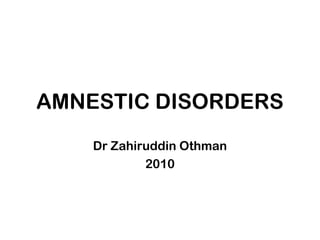Amnestic disorders
- 1. AMNESTIC DISORDERS Dr Zahiruddin Othman 2010
- 2. ICD-10: Organic Mental Disorder F00 Dementia in Alzheimer disease F01 Vascular dementia F02 Dementia in other diseases classified elsewhere F03 Unspecified dementia F04 Organic amnesic syndrome, not induced by alcohol and other psychoactive substances F05 Delirium, not induced by alcohol and other psychoactive substances F06 Other mental disorders due to brain damage and dysfunction and physical disease F07 Personality and behavioral disorders due to brain disease, damage and dysfunction F08 Unspecified organic or symptomatic disorder
- 3. DSM-IV: Cognitive Disorders DELIRIUM Delirium due to a GMC DEMENTIA AMNESTIC DISORDER 294.0 Amnestic disorder due to a GMC 294.8 Amnestic disorder NOS OTHER COGNITIVE DISORDERS
- 4. Cognitive change Impaired Consciousness or Attention Acute onset Fluctuating course Organic cause Language Orientation Perception Aphasia Agnosia Apraxia Executive def. AMNESTIC DISORDER DEMENTIA DELIRIUM Cognitive deficits AmnesiaAmnesia Amnesia Organic causeOrganic cause
- 5. Memory Disturbances CLINICAL Time / onset DISORDER cause AMNESIA loss of memory AMNESTIC (organic) DISSOCIATIVE (psychogenic) anterograde retrograde PARAMNESIA error of memory CONFABULATION Unconscious filling up gaps in memory DEJA VU “already seen” in French
- 7. HM’s lesion: bilateral medial temporal lobe removal
- 8. Nondeclarative (implicit) Declarative (explicit) Long-term memory Simple classical conditioningFact Event Procedural (skill & habit) priming emotional Skeletal musculature Nonassociative learning Reflex pathwaysStriatum Medial temporal lobe Diencephalon Neocortex CerebellumAmygdala Squire’s Memory Taxonomy
- 9. What is affected? What is impaired? Anterograde amnesia, episodic memory: dramatic inability to learn something new after the onset of amnesia due to inability to build up new episodes. Retrograde amnesia, an inability to retrieve information that was learned prior to the onset of amnesia if it was not purely semantic or implicit memory Impaired temporal localization of past experience, as in Korsakoff, which leads to confabulation Autobiographic memory also intact, but amnesic for recent events before onset of amnesia
- 10. Confabulation • ‘‘False statements that are not made to deceive, are typically more coherent than thoughts produced during delirium” • It ranges from small distortions on laboratory tasks to striking bizarre stories that patients tell in describing their personal histories • Typically occurs in the context of executive deficits such as perseveration, poor self- monitoring, and difficulty with self-initiated processes
- 12. Transiet Global Amnesia [TGA] • Characterized by a dense, transitory inability to learn new information and a variable inability to recall events • Assoc. with cerebrovascular disease and pathology in vetebrobasilar system
- 13. BLACKOUTS Blackouts are periods of amnesia for events that occur during heavy drinking. Typically, a person awakens the morning after consumption and does not remember what happened the night before. Blackouts are more a measure of the amount of alcohol consumed at any one time.
- 14. Chronic Amnestic Disorders Causes - Pathological Process Damage to specific diencephalic and mediotemporal lobe structures (e.g., mamillary bodies, hippocampus, fornix) – head trauma – surgical intervention – infarction of the distribution of PCA – hypoxia – herpes simplex encephalitis
- 15. • “Persisting” means the memory disturbances persists long after the effects of substance intoxication or withdrawal have ended • CNS depressants – Alcohol, sedatives, hypnotics, anxiolytics, anticonvulsants • Toxin: lead, mercury, intratheceal methotrexate, organophosphate insecticides, and industrial solvents Substance-Induced Persisting Amnestic Disorder
- 16. WERNICKE-KORSAKOFF SYNDROME [WKS] Acute WKS: Mammillary bodyAcute WKS: Mammillary body hemorrhageshemorrhages Old WKS: mammillary bodyOld WKS: mammillary body atrophyatrophy Seen in Alcoholics Gastric cancer Hyperemesis gravidarum
- 17. Treatment • The primary goal in the amnestic disorders is to discover and treat the underlying cause. • Some of these causes of amnestic disorder are associated with dangerous self- damaging behavior – e.g., suicide attempts by hanging, carbon monoxide poisoning, deliberate motor vehicle accidents, self-inflicted gunshot wounds to the head and chronic alcohol abuse
Editor's Notes
- Anterograde amnesia, episodic memory: dramatic inability to learn something new after the onset of amnesia due to inability to build up new episodes. Retrograde amnesia, an inability to retrieve information that was learned prior to the onset of amnesia if it was not purely semantic or implicit memory Contingent upon RA: impaired temporal localization of past experience, as in Korsakoff, which leads to confabulation Autobiographic memory also intact, but amnesic for recent events before onset of amnesia
- Encephalitis: Herpes simplex encephalitis (HSE), a viral infection causing lesions in the limbic regions in the temporal lobe, hippocampus, entorhinal, perirhinal, parahippocampal crtices, amygdala, and polar limbic cortices (O'Connor & Verfaille, 2004) Anoxia: oxygen deficit due to decreased vascular perfusion or reduced oxygen content in the blood, caused by e.g., cardiac arrest or respiratory distress. Most likely, hippocampal damage is involved, but also basal ganglia, thalamus, white matter projections and diffuse cortical areas. (O'Connor & Verfaille, 2004)
- http://www.neuropathologyweb.org/chapter8/chapter8Nutritional.html The histopathology of WKS is incomplete loss of neurons, damage of axons and myelin which casuses loosening or vacuolization of the neuropil, and punctate hemorrhages. The lesions have a characteristic anatomical distribution which includes the mammillary bodies, the hypothalamus, thalamus, periaqueductal gray matter, colliculi, and the floor of the fourth ventricle. The mammillary bodies are involved in all cases. This is the hallmark of WKS. Lesions of the colliculi and the floor of the fourth ventricle (oculomotor nuclei, vestibular nuclei, dorsal motor nuclei of the vagus) cause the oculomotor and brain stem signs. Involvement of the medial dorsal nucleus of the thalamus is responsible for the memory defect. An identical memory defect (Korsakoff's amnesia) is caused by bilateral hippocampal damage. The hippocampus projects to the mammillary bodies via the fornix but is not affected in the WKS. The MRI shows a hyperintense FLAIR signal in the affected areas. In full-blown WKS, all these structures are involved. In less severe cases, some may be spared. Each successive bout of WKS causes additional loss of neural tissue. Old cases show atrophy of the mammillary bodies and dilatation of the third ventricle. In 30% to 50% of cases, the cerebellum shows degeneration (neuronal loss) of the superior vermis

